India and China are intensifying their lunar ambitions with advanced plans to send astronauts to the Moon within the next decade. China targets 2030 for a manned lunar landing, while India aims for 2040, marking major milestones in their space exploration and potential future collaborations on the lunar surface.
India and China, two rising space powers, are making significant strides toward manned lunar missions. China has reaffirmed its goal to land astronauts on the Moon by 2030, progressing steadily with the development of the Long March 10 rocket, lunar landing suits, and exploration vehicles. The upcoming crew for China’s Tiangong space station mission demonstrates its growing capabilities in human spaceflight.
India, on the other hand, has articulated ambitions to send its first astronauts to the Moon by 2040, coinciding with the centenary of Indian independence. This follows successful unmanned lunar missions like Chandrayaan-3, signaling strong momentum in India’s human spaceflight and lunar exploration programs.
Additionally, both nations are exploring cooperative frameworks, potentially including joint lunar infrastructure projects with Russia. This collaboration could help establish nuclear-powered lunar bases, supporting long-term human presence.
As global lunar exploration heats up, with aims for research and colonization, India and China’s twin lunar ventures position Asia as a critical player in humanity's next giant leap.
Key Highlights
-
China aims to land astronauts on the Moon by 2030, with ongoing rocket and suit development.
-
India plans a manned lunar mission by 2040, following successful Chandrayaan missions.
-
Both countries engage in international lunar projects, including nuclear power plants for future lunar bases.
-
China’s Tiangong space station serves as a platform for astronaut training and extended human spaceflight.
-
Collaboration with Russia in space infrastructure strengthens Asia's role in lunar exploration.
-
These missions underline the competitive yet cooperative spirit driving new frontiers in space.
Sources: Economic Times, India TV News, National Herald India, China Manned Space Agency, Futurism, The Federal, NDTV, Business Today
